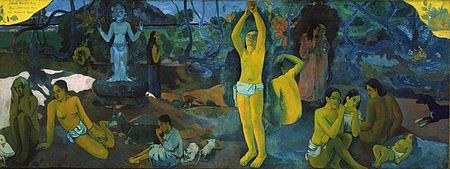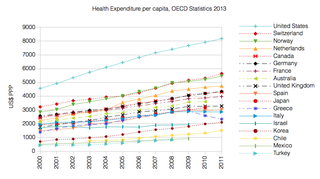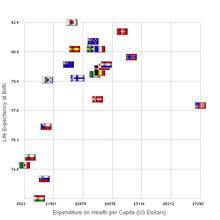Healthcare in Switzerland
|
Read other articles:

Pour les articles homonymes, voir gorge. Cet article est une ébauche concernant l’anatomie. Vous pouvez partager vos connaissances en l’améliorant (comment ?) selon les recommandations des projets correspondants. Consultez la liste des tâches à accomplir en page de discussion. Diagramme des parties de la gorge humaine En anatomie, la gorge est la partie du cou antérieure à la colonne vertébrale. Elle consiste en deux parties : le pharynx et le larynx, eux-mêmes composés de…

Disambiguazione – Se stai cercando altri significati, vedi Campus (disambigua). Campus dell'Università del Minho ad Azurém, Guimarães Il campus è un'area in cui sono situati alcuni o tutti gli edifici di un'università. In italiano viene adottato spesso come sinonimo di cittadella universitaria. Indice 1 Storia 2 Caratteristiche 2.1 Campus universitari in Italia 3 Luoghi di culto 4 Note 5 Voci correlate 6 Altri progetti 7 Collegamenti esterni Storia Nonostante il termine sia latino, è sta…

Christopher Nolan reçoit l'Oscar du meilleur réalisateur pour son film Oppenheimer en 2024. L’Oscar du meilleur réalisateur (Academy Award for Best Director) est une récompense cinématographique américaine décernée chaque année, depuis 1929 par l'Academy of Motion Picture Arts and Sciences (AMPAS), laquelle décerne également tous les autres Oscars. Exception faite de la 1re cérémonie des Oscars, qui fut la seule fois dans l'histoire des Oscars où deux réalisateurs furent r�…

Bản đồ Nam Mỹ; kinh tuyến bên phải được vạch ra bởi Inter caetera, còn kinh tuyến bên trái là theo Hiệp ước Tordesillas. Bản đồ vẽ biên giới các quốc gia và đánh dấu các thành phố hiện nay nhằm mục đích minh hoạ. Inter caetera (tiếng La-tinh nghĩa là Giữa các việc khác) là một tông sắc được Giáo hoàng Alexander VI ban hành vào ngày 4 tháng 5 (quarto nonas maii) năm 1493, ban cho hai vị Quân chủ Công g…

Cheese from Central Anatolia, Turkey Çömlek cheeseOther namesComlek peyniriCountry of originTurkeyRegion, townCappadociaRegionCentral AnatoliaSource of milkcows or sheep Related media on Commons Çömlek cheese is a typical artisanal cheese from Central Anatolia, meaning pot cheese. See also Pot cheese References Bulut C, Gunes H, Okuklu B, Harsa S, Kilic S, Coban HS, Yenidunya AF (Feb 2005). Homofermentative lactic acid bacteria of a traditional cheese, Comlek peyniri from Cappadocia region. …

Country house in Norfolk, England For other uses, see Houghton Hall (disambiguation). The façade of Houghton Hall in 2007 The façade of Houghton Hall from Colen Campbell's Vitruvius Britannicus. The corner towers were replaced with domes in the final design. Houghton Hall (/ˈhaʊtən/ HOW-tən)[1] is a country house in the parish of Houghton in Norfolk, England. It is the residence of the 7th Marquess of Cholmondeley.[2] It was commissioned by the de facto first British Prime …

Частина серії проФілософіяLeft to right: Plato, Kant, Nietzsche, Buddha, Confucius, AverroesПлатонКантНіцшеБуддаКонфуційАверроес Філософи Епістемологи Естетики Етики Логіки Метафізики Соціально-політичні філософи Традиції Аналітична Арістотелівська Африканська Близькосхідна іранська Буддійсь…

Ligament connecting vertebral bodies of all of the vertebrae Posterior longitudinal ligamentPosterior longitudinal ligament, in the thoracic region. (Posterior longitudinal ligament runs vertically at center.)Median sagittal section of two lumbar vertebrae and their ligaments. (Posterior longitudinal ligament runs vertically at center left.)DetailsSystemskeletalIdentifiersLatinligamentum longitudinale posteriusTA98A03.2.01.008TA21680FMA31894Anatomical terminology[edit on Wikidata] The poster…

Sporting event delegationMalaysia at theOlympicsIOC codeMASNOCOlympic Council of MalaysiaWebsitewww.olympic.org.my (in English)MedalsRanked 114th Gold 0 Silver 8 Bronze 5 Total 13 Summer appearances195619601964196819721976198019841988199219962000200420082012201620202024Winter appearances20182022Other related appearances North Borneo (1956) Malaysia first participated at the Olympic Games in 1956, and has sent athletes to compete in every Summer Olympic Games since then, except when Mal…

Trading posts of the Dutch West India Company on the Slave Coast Part of a series onForced labour and slavery Contemporary Child labour Child soldiers Conscription Debt Forced marriage Bride buying Child marriage Wife selling Forced prostitution Human trafficking Peonage Penal labour Contemporary Africa 21st-century jihadism Sexual slavery Wage slavery Historical Antiquity Egypt Babylonia Greece Rome Medieval Europe Ancillae Black Sea slave trade Byzantine Empire Kholop Prague slave trade Serfs …

Indian Public Policy Think-tank Not to be confused with Centre for Public Policy Research. This article has multiple issues. Please help improve it or discuss these issues on the talk page. (Learn how and when to remove these template messages) This article may need to be rewritten to comply with Wikipedia's quality standards. You can help. The talk page may contain suggestions. (September 2022) This article needs additional citations for verification. Please help improve this article by adding …

Passerine species of bird native to the Chatham Islands For the Turdus thrush of Central America, see Black thrush. Black robin Conservation status Vulnerable (IUCN 3.1)[1] Scientific classification Domain: Eukaryota Kingdom: Animalia Phylum: Chordata Class: Aves Order: Passeriformes Infraorder: Passerides Family: Petroicidae Genus: Petroica Species: P. traversi Binomial name Petroica traversi(Buller, 1872) Synonyms Miro traversi The black robin or Chatham Island robin (Morior…

Untuk radikal Italia bernama sama, lihat Gregorio Fontana (radikal). Gregorio FontanaLahir(1735-12-07)7 Desember 1735Nogaredo, ItaliaMeninggal24 Agustus 1803(1803-08-24) (umur 67)Milan, ItaliaKebangsaanItaliaDikenal ataskoordinat kutubKarier ilmiahBidangGeometriMahasiswa ternamaPietro Paoli Gregorio Fontana, bernama lahir Giovanni Battista Lorenzo Fontana (7 Desember 1735 – 24 Agustus 1803) adalah seorang matematikawan dan anggota keagamaan ordo Piaris asal Italia. Ia menjad…

Danny DenzongpaDenzongpa pada Februari 2010LahirTshering Phintso Denzongpa25 Februari 1948 (umur 76)[1]Gangtok, IndiaTempat tinggalMumbai, Maharashtra, IndiaKebangsaanIndiaPekerjaanPemeran, Penyanyi, PengusahaTahun aktif1963–sekarangSuami/istriGawa DenzongpaAnakRinzing Denzongpa,Pema Denzongpa Danny Denzongpa (lahir 25 Februari 1948) adalah seorang pemeran, penyanyi dan sutradara India keturunan Bhutia Sikkim. Ia biasanya berkarya dalamn perfilman Bollywood, selain ia juga ta…

1997 compilation album by Various ArtistsNow That's What I Call Music! 3Compilation album by Various ArtistsReleasedSeptember 1, 1997LabelEMI / Virgin / PolyGramVarious Artists chronology Now That's What I Call Music! 2(1996) Now That's What I Call Music! 3(1997) Now That's What I Call Music! 4(1998) Now That's What I Call Music! 3, also referred to as Now 3, was released on September 1, 1997[citation needed]. The album is the third edition of the Asia Now That's What I Call Musi…

خمس قطع سهلةFive Easy Pieces (بالإنجليزية) معلومات عامةالصنف الفني دراماتاريخ الصدور 1970مدة العرض 96 دقيقةاللغة الأصلية الإنجليزيةالبلد الولايات المتحدةمواقع التصوير كاليفورنيا — كولومبيا البريطانية الجوائز القائمة ... جائزة الجمعية الوطنية للنقاد السينمائيين لأفضل ممثلة …
River in FranceTernoiseShow map of FranceShow map of Hauts-de-FranceLocationCountryFrancePhysical characteristicsSource • locationPas-de-Calais Mouth • locationCanche • coordinates50°22′53″N 2°0′41″E / 50.38139°N 2.01139°E / 50.38139; 2.01139Length41.4 km (25.7 mi)Basin size342 km2 (132 sq mi)Discharge • average4.45 m3/s (157 cu ft/s) …

Bagian dari seriIslam Rukun Iman Keesaan Allah Malaikat Kitab-kitab Allah Nabi dan Rasul Allah Hari Kiamat Qada dan Qadar Rukun Islam Syahadat Salat Zakat Puasa Haji Sumber hukum Islam al-Qur'an Sunnah (Hadis, Sirah) Tafsir Akidah Fikih Syariat Sejarah Garis waktu Muhammad Ahlulbait Sahabat Nabi Khulafaur Rasyidin Khalifah Imamah Ilmu pengetahuan Islam abad pertengahan Penyebaran Islam Penerus Muhammad Budaya dan masyarakat Akademik Akhlak Anak-anak Dakwah Demografi Ekonomi Feminisme Filsafat Ha…

Eastern Christian denomination Not to be confused with Assyrian Church of the East or Church of the East. Ancient Church of the EastCathedral of the Virgin Mary Baghdad, IraqAbbreviationACEClassificationEastern ChristianityOrientationSyriac ChristianityCatholicos-PatriarchGewargis III YounanLanguageSyriacLiturgyEast Syriac RiteHeadquartersBaghdad, IraqSeparated fromAssyrian Church of the EastMembers70,000 in 1968;[1] approx. 75 000, of which 45 000 in Iraq and 20 000 in India (1999)[…

Grupo Desportivo Fabril do BarreiroHockey su pista Segni distintiviColori sociali Bianco e Verde Dati societariCittàBarreiro Paese Portogallo Confederazione CERH Federazione FPP Fondazione1937 PalmarèsTitoli nazionali1 grupodesportivofabril.pt Il Grupo Desportivo Fabril do Barreiro è un club polisportivo avente sede a Barreiro in Portogallo. La sezione più celebre è quella di hockey su pista Indice 1 Palmarès 1.1 Hockey su pista 1.1.1 Competizioni nazionali 1.2 Calcio 1.2.1 Competizio…






